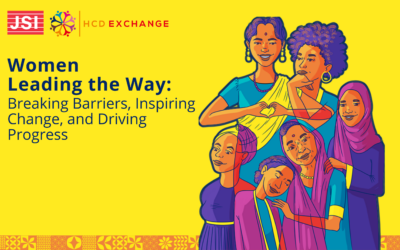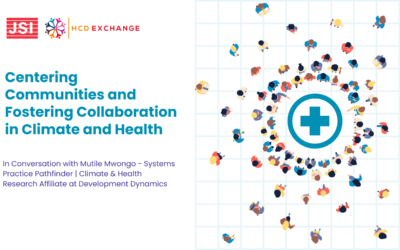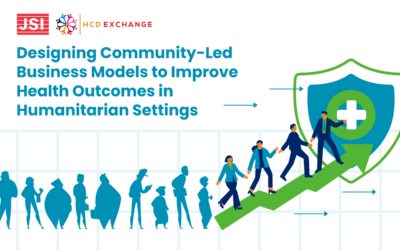Find Nzisa’s first learning and reflection session here.
In our first learning and reflection session you spoke about how you came to be a human-centered designer, after starting out as an interior designer. Can you tell me what attracted you to the field of HCD? Why not some other form of design?
I think in HCD, a designer does not design only because they have the papers and qualifications to design. Designing tries to solve someone’s problem, the best way it can. In HCD the people you are designing for inform the solutions, compared to the way that I was practicing design before – when I just used to do ‘designer’s design’. What makes me want to keep pursuing HCD is the impact that it can have on people’s lives – it may not be immediate, it may not be very big but it can change someone’s life for the better. That is what makes doing HCD worthwhile for me.
In our last interview you spoke about your work with YLabs to create a digital solution for the FAYA curriculum. The team had gone to the field, gathered insights using prototypes, and was creating a solution called ‘AskDoki’ which disseminated the FAYA curriculum through a Whatsapp chatbot called ‘Doki’. How has the project progressed since then?
 So after that, we went through a round of user testing to learn about young people’s preferences, and gathered feedback that helped us keep developing the chatbot. This phase also helped us decide on the brand, logos, colours, the face of ‘AskDoki’ and other elements of the chatbot. We were also looking at how people interact with the chatbot. We learnt from this round of user testing and applied it to the chatbot. After this we did mini pilots in the month of May where we engaged the Youth Advocacy board that I spoke about in my previous session, from Homabay and the other three counties and/or sub-counties that we are working in. We asked them to help us share AskDoki with young people as well as help us get users for the chatbot because they are in touch with the young people. They helped us build awareness about Doki the chatbot.
So after that, we went through a round of user testing to learn about young people’s preferences, and gathered feedback that helped us keep developing the chatbot. This phase also helped us decide on the brand, logos, colours, the face of ‘AskDoki’ and other elements of the chatbot. We were also looking at how people interact with the chatbot. We learnt from this round of user testing and applied it to the chatbot. After this we did mini pilots in the month of May where we engaged the Youth Advocacy board that I spoke about in my previous session, from Homabay and the other three counties and/or sub-counties that we are working in. We asked them to help us share AskDoki with young people as well as help us get users for the chatbot because they are in touch with the young people. They helped us build awareness about Doki the chatbot.
For the mini pilots, we wanted to learn how people are using AskDoki, the acceptance levels amongst the youth and whether what we set out to do was happening. So we did a mini recruitment exercise of the people who had already interacted with AskDoki so that we could learn from them about their experience. We also wanted to learn what needs to change to make the experience better for the users. We were looking for some specific answers to questions that align with the FAYA evaluation strategy. For example – if someone was looking for a facility, did they get the facility they wanted? Did they get the information they needed at the time that they needed it?
The mini pilots ended up being like a small launch of AskDoki where it was open for use for people in Homabay, Siaya, Mombasa and Malindi. We disseminated it in these four sub counties so that we could learn from the mini pilot and plan better for the main launch. We also launched an Instagram ad campaign to help us reach more people in these four sub counties. All through the time that AskDoki was out there being used, we were collecting data through chatbot analytics, and also through some mini interviews with some of the people that had already been using AskDoki.
Did the insights that were generated in the early stages contribute to the later stages of piloting AskDoki?
 Yes they did. We were iterating at every point. So whatever we learned at one stage was included in the prototypes of the next stage. This also helped us see how people react to what we are learning from other people within the same audience. We kept iterating and iterating leading up to the second launch.
Yes they did. We were iterating at every point. So whatever we learned at one stage was included in the prototypes of the next stage. This also helped us see how people react to what we are learning from other people within the same audience. We kept iterating and iterating leading up to the second launch.
For example, one of our initial assumptions from a previous iteration was that since AskDoki is a chatbot that’s talking about sexual reproductive health, young people may not want AskDoki to be readily visible on their phones. As a result, we asked young people whether they would share AskDoki or not, what are their reasons for sharing or not sharing, and who they would share it with. We learned that young people do not actually mind sharing AskDoki. However, even though they had the link to share AskDoki, most of them did not know how to share it. As a result, we included step by step instructions on how to share AskDoki in the next iteration.
Was there any one process or method that you used during synthesis, or even ideation that you found crucial to the development of ‘AskDoki’ in a human-centered way?
 I would say the data collection mechanisms we had in place. Normally, if you’re doing an interview in real time, you’ll be writing notes in your notebook, so that you can refer to them later when you’re trying to create insights. However, for this process, because we did a lot of remote interviews, we would input answers to the questions that were asked into an Excel sheet – question by question. From those excel sheets it was much easier to transfer the data points to Mural for synthesis.
I would say the data collection mechanisms we had in place. Normally, if you’re doing an interview in real time, you’ll be writing notes in your notebook, so that you can refer to them later when you’re trying to create insights. However, for this process, because we did a lot of remote interviews, we would input answers to the questions that were asked into an Excel sheet – question by question. From those excel sheets it was much easier to transfer the data points to Mural for synthesis.
The other process that I found useful, and it’s not anything big, was talking about what you’re learning on a particular day with your team and making sure that the data for every interview has been captured somewhere so that you do not forget what you learned. If you don’t do that, I think you run the risk of getting all muddled up because you’re talking to a lot of people with different opinions. Also when you get to debrief with another team member, they may have noticed something you didn’t notice or captured something you didn’t capture. That is a learning point that you take note of, for the next interviews that you conduct, or you include it in the data downloads that you have.
Similarly, was there any process that was challenging when developing ‘AskDoki’?
The process of setting up interviews and doing a follow up for the same respondent was very difficult especially when doing it remotely. We had to keep reminding people that we have an interview with you, and that we will call you at this time, and can you please ensure that you are in a non distracting environment if possible. Sometimes, despite all that due diligence and them confirming that they will be there, timing would be an issue or the environment would be very distracting.
How were young people involved in the testing and implementation phases of ‘AskDoki’?
 Everyone we spoke to during the testing phase was in the youth category. We included young people from the time we started user testing to the time we went to launch. We also collaborated with the youth through a mechanism called the Youth Advocacy board, which is made up of young people to help us disseminate ‘AskDoki’ to people, and also help us recruit some people for user testing. Alongside the testing of AskDoki, the media within AskDoki was also created with young people. We approached young people, did scripts, and then did videos or photos for AskDoki with young people. We created the initial drafts of the scripts for them, and then they reviewed them and worked out the nitty gritties to reach a final draft on their own, based on what they would be most okay with. We are now planning for implementation and the Youth advocacy Board through Amref has been such a great addition to the planning processes.
Everyone we spoke to during the testing phase was in the youth category. We included young people from the time we started user testing to the time we went to launch. We also collaborated with the youth through a mechanism called the Youth Advocacy board, which is made up of young people to help us disseminate ‘AskDoki’ to people, and also help us recruit some people for user testing. Alongside the testing of AskDoki, the media within AskDoki was also created with young people. We approached young people, did scripts, and then did videos or photos for AskDoki with young people. We created the initial drafts of the scripts for them, and then they reviewed them and worked out the nitty gritties to reach a final draft on their own, based on what they would be most okay with. We are now planning for implementation and the Youth advocacy Board through Amref has been such a great addition to the planning processes.
So far how has the project evaluated its impact and outcomes?
 We are currently using chatbot analytics on Google, to understand what people are looking at, how people are learning, what is the rate of drop offs, and what is the user behavior online. We also used WhatsApp calls as part of user testing with young people to understand the way young people received AskDoki, what they thought about the information, whether it was helpful, and what they would like as an addition to what we have.
We are currently using chatbot analytics on Google, to understand what people are looking at, how people are learning, what is the rate of drop offs, and what is the user behavior online. We also used WhatsApp calls as part of user testing with young people to understand the way young people received AskDoki, what they thought about the information, whether it was helpful, and what they would like as an addition to what we have.
We have an evaluation strategy as well that we are working with. Basically, we are learning different things from the evaluation strategy. We have trends to understand the number of adolescents using it, the number of users who visit, the number of users who are coming back, the number of users who left without continuing for a certain amount of time, what a young person is looking for on AskDoki, and the number of users who are completing chapters. Overall the evaluation strategy is looking at desirability, completion, engagement, and acceptability.
We will now shift gears to hear more about you and your practice. What shifts have you made in your practice as a human-centered designer while working in the adolescent sexual and reproductive health field?
One big shift is the understanding of the importance of safeguarding. In interviews with young people before we used safeguarding practices because of conversations with management but I never really realized the importance. For adolescent sexual and reproductive health it has been very evident that you need to safeguard the people you are talking to and that we need to make them comfortable while we are working with them. I encountered interviews where boys would say they don’t want to talk to me because I’m a girl. We were two interviewers and the other was male so I would sit out for those interviews. This was a new situation for me, and I had never been in such a situation but then this gives you a chance to see a different side of field interviews.
I also think I learned that HCD is not a ‘one size fits all’ process. The design, as well as the designer, also changes as you go, depending on the processes. So what you do as a designer keeps changing as you go, as well as your perspective. For different projects it can be so different. It is very dynamic because HCD is not set in stone. There is no ‘this is how it’s supposed to be’. There are many moving pieces that work differently in different settings. I think working with YLabs has taught me that. Prior to YLabs I came with an understanding of certain processes, and I tried to assimilate others into what I know. But now, I know that we all have to be empathetic to everyone’s knowledge base, because we all come from different backgrounds and will know different things. Some work, some don’t.
What has been your biggest takeaway from this fellowship?
The connections I’ve made during the fellowship have been amazing. More importantly though I would say that the confidence to speak about what I have done from start to end has been a big thing for me. I feel like I am now a part of something that has gone through research and is now being implemented. Before, I would never be included in the implementation phase as a designer. This has been a really, really interesting way of seeing design come from desktop research all the way through to implementation. Being in an environment where people actually implement what you design, and seeing what you worked on come to fruition has been so good. It is now a tangible product that I can say I was part of creating.
What is next for you post the fellowship?
I have been offered a full time job by YLabs as a design researcher! So I’m looking forward to seeing where that takes me. YLabs offers a lot of mentorship opportunities and I am currently open to wherever my journey is going to be taking me. The one thing I know is that this is going to be a journey of growth.
What advice would you like to give emerging designers in the field of ASRH?
Be hungry to learn. There is no solid manual that exists for this. Even the way you build out your career path is part of HCD. As an emerging designer making sure that you are present at every stage of the process because you get to learn many different things and this is quite important before you decide this is a path you want to take or this is how you want to do. Being open to whatever comes up, being open to learning, being open to new experiences because it opens you up to this whole world of possibilities.
I would also say that it is not hard to work in this field, and it is not easy to work in this field. It is trying, and it’s going to open you up to a lot of possibilities that you never thought of, and it’s going to shake your core sometimes. The important thing is to know what you want out of working in this field, and know where you’re going with it.
Learn More:
- Twitter: @Nzisakay @ylabsglobal
- LinkedIn: https://www.linkedin.com/in/nzisairenekioko/
- Personal website: https://keystrokesbynzisa.wordpress.com
- Organizational website: https://www.ylabsglobal.org/
Copyright:
This story is copyright [NZISA IRENE KIOKO] and published on the HCDExchange website under a Creative Commons Attribution 4.0 International license.
This interview was conducted by Rimjhim Surana.




